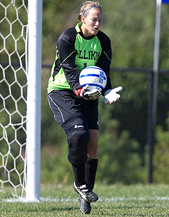 They may play different sports, but the Hirsch twins are, indeed, mirrors of each other. Active in basketball, softball and soccer for much of their childhood, Jennifer and Alayna Hirsch have undergone knee surgeries to treat ligament tears. Now, after some well-spent time helping each other recover and prepare for active sports seasons, both are in their senior year at Millikin University in Decatur, IL.
They may play different sports, but the Hirsch twins are, indeed, mirrors of each other. Active in basketball, softball and soccer for much of their childhood, Jennifer and Alayna Hirsch have undergone knee surgeries to treat ligament tears. Now, after some well-spent time helping each other recover and prepare for active sports seasons, both are in their senior year at Millikin University in Decatur, IL.“We were anxious to play sports in our last year at college,” says Alayna. “I think we both worked hard to keep up with physical therapy and strengthening exercises so that we would be in good shape for the upcoming coming season.”
Alayna was the first to undergo surgery to reconstruct a torn anterior cruciate ligament (ACL) in her left knee that occurred while playing basketball at Parkway North High School in January, 2001. “I was a freshman point guard for the women’s basketball team and it was the end of a game when I went up for a lay-up. When I landed, I hyper-extended my knee and felt a pop,” says Alayna. “It was a very sharp pain. I let it rest for a couple of weeks and then tried to play in another game, but my knee gave out during warm-ups. My athletic trainer took one look and said I probably tore my ACL.”
The ACL is one of four major ligaments that stabilize the knee. In active individuals, especially those playing sports with rapid changes in direction such as soccer, baseball, hockey, football, or skiing, an ACL tear is one of the most common significant injuries to the knee.
“Once an ACL is torn, it cannot heal or repair itself,” says Rick Wright, MD, co-chief of sports medicine service with Washington University Orthopedics and team physician for the St. Louis Blues and St. Louis Rams. “We can improve range of motion and mobility with muscle-strengthening exercises to a small extent, but reconstructive surgery is the best option for those who want to regain an active lifestyle.”
Torn ACLs are reconstructed by taking strong, healthy tissue from either the patient’s patellar tendon (a strip of tendon underneath the kneecap) or a hamstring and surgically attaching the graft to the thighbone and shinbone. Donated cadaver tendons also can be used. The procedure restores stability.
Alayna underwent several months of physical therapy to get back in shape again to play high school sports. In a strange twist of fate, her sister Jennifer suffered the same injury and underwent ACL reconstruction later that fall.
“I was playing softball and twisted suddenly while throwing the ball in from the outfield,” she recalls. “I knew immediately that something was wrong.”
After four to six months of physical therapy, Jennifer also went back to an active schedule of high school sports. Both girls were later recruited by Milliken University to play multiple sports.
Fast forward to 2007. In what looked like a repeat of their earlier injuries, the Hirsch twins were again playing their favorite sports at Millikin — Jennifer playing soccer and Alayna on the softball team — when each tore the ACL in their opposite knees within two months of each other.
“Unfortunately, it’s not surprising that they injured their other knees,” says Dr. Wright, who has specialized in ACL reconstruction and other knee procedures for more than 13 years. “Research has shown that the opposite normal knee is just as likely to rupture after ACL reconstruction of the first knee. And women seem to be more prone to ACL tears than men.”
Dr. Wright is a principal investigator in the MultiCenter Orthopaedic Outcome Network (MOON) for ACL reconstruction. For the past several years, a national network of orthopedic surgeons in nine medical centers has been tracking ACL reconstruction patients to determine what risk factors lead to the development of a second ACL tear or the onset of osteoarthritis or decreased mobility in either knee. Investigators are also closely evaluating the differences in male and female anatomy to see how gender plays a role in the potential for ACL injuries.
“By following a large number of ACL patients in all of the medical centers involved, we hope to identify the variables that enable us to predict which patients are more likely to develop future injuries,” says Dr. Wright. “We can then evaluate treatment and therapy options to try to prevent those secondary injuries from occurring.”
Both Jennifer and Alayna Hirsch are enrolled in the MOON study and will be evaluated over the next 10 years to see how they continue to recover from their dual ACL reconstructions. For now, each is looking forward to an exciting senior year of sports at Millikin University and completing requirements for degrees in physical education and sports fitness.
“There’s always a little angst as I watch them get ready to play soccer or softball,” says the girls’ mom, Nancy. But they’re excited about their senior year and I’m glad to know that they are working on strengthening their legs and getting in shape again. “Playing sports is their passion and we’ve been fortunate to find great medical care for both of them.”
Which blog you have shared here really informative and interesting , I like it .
ReplyDeleteAmino Acid Derivatives